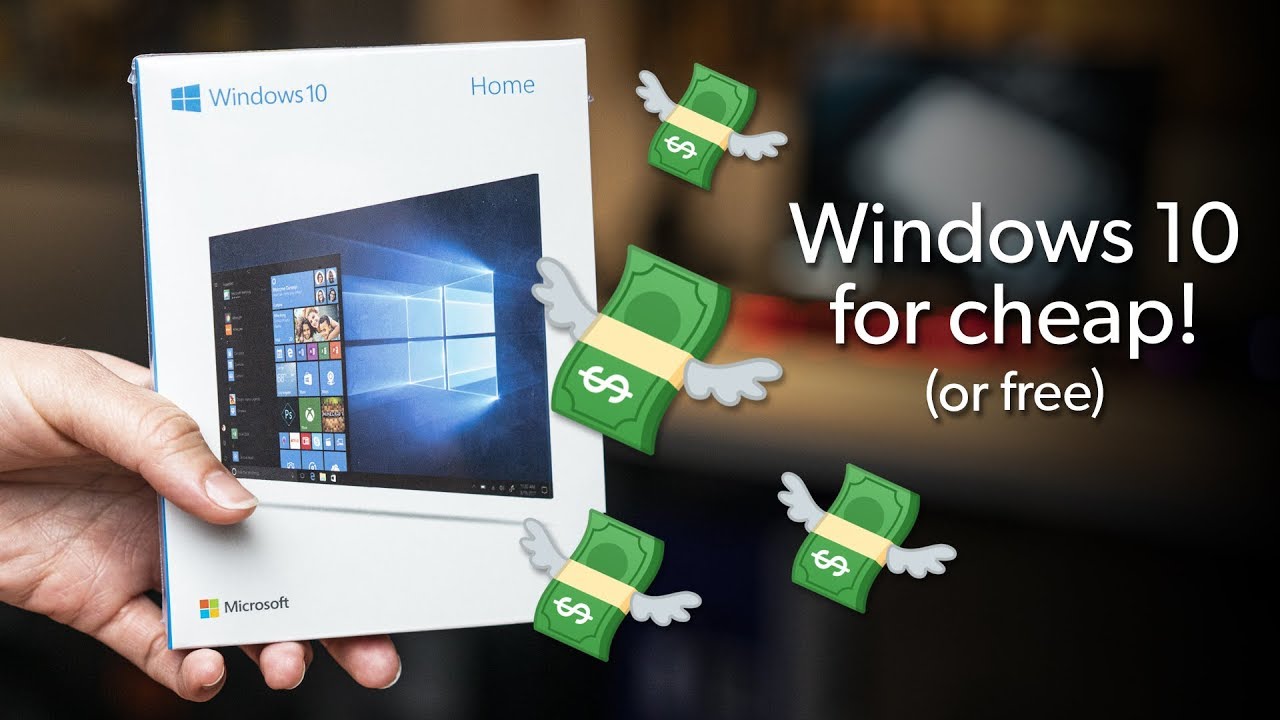Existing customer? Sign in
How to get Windows 10 cheap (or even for free!)

How to Get a Cheap or Free Windows 10 License
Hey, PC World fans, Adam here, and I have a question for you. Lena, I just built a PC at home and I spent all of my money on a really nice graphics card and I don’t have any money left over for a Windows 10 license. Is there any way I can find one for cheap or cheaper or maybe even free?
Actually, yes! There are ways to get it for, well, technically free.
Option 1: Buy an OEM License
The first option is probably the easiest and the one that generates the least controversy in our office, which is to just go out and buy an OEM license. I’ve actually done that before. The problem I have is that it’s tied to a single computer. There is weird licensing stuff like why is it so weird like that?
Well, that’s what you exchange for a discount. Typically, a retail license will cost you what, like $139 for Windows 10 Home and $200 for Windows 10 Pro if you walked into Best Buy or went directly to Microsoft and bought it. An OEM license, in exchange for slightly higher restrictions on what you can do with the software, gives you a bit of a discount. All the features are the same, but you can only install it on that one PC. The retail version, where you pay more, allows you to transfer the license to a new PC down the road without any hassle.
The way the activation servers recognize your system is by generating a unique key based on certain components in your system, and the motherboard is one of them. If your motherboard bites it and you have to replace it, the servers often won’t recognize your PC anymore. But if you replace an SSD, power supply, or GPU, it should be no problem. You’re fine until you get a new motherboard. In the past, Microsoft’s been lenient about this, allowing you to reactivate if you go through their process, but it’s still a hassle.
OEM licenses usually cost $110 for Home and $150 for Windows 10 Pro, so you’re saving between $20 to $50, which is not a huge amount but still some savings in exchange for a bit of hassle. It’s hard to get a Windows 10 discount, so people often go this route.
Option 2: Look for Sales or Discounts
Do they ever go on sale? Could you get it even cheaper?
Yes, sometimes Newegg will have a discount if you watch their daily newsletter. However, it’s not predictable when they do that. The most predictable time of year to do it would be Black Friday. Last year, it was $85 for the Home version and $120 for the Pro version, which is a decent discount, but you have to wait. If you’re willing to wait, this might be an option for you.
Option 3: Education Discount
Number two is far more complex, but this is the way you can get a free, quote-unquote, version. Nothing in life is free, right? This strategy is something I can only recommend for US residents. I don’t know what it’s like in other countries. Basically, you’re looking for an education discount. If you’re an adult and no longer in college, you can sign up for courses at a community college. About half of the colleges I looked at offered some kind of version of Windows 10.
The way it works is that you have to be a student in active standing. You can do this by signing up for a one-unit class. Some of these classes are physical education, like a swim class or a boot camp class, or other subjects like Intro to Drawing, HTML, CSS, or Video Production. In California, which is one of the cheapest states, a one-unit class costs about $76, including administrative fees. California offers Windows 10 Education, which is like Windows 10 Pro but better because it’s closer to the enterprise version of Windows. You get a bunch of additional features, and it’s a free license, though you have to pay for the class.
So, out-of-pocket, it costs $76, but you get the Windows 10 license and the class, which is a pretty good deal if you were thinking about taking classes anyway. Some colleges also offer other bonuses like free Office 365 accounts, access to Microsoft Word, Excel, PowerPoint, and sometimes Adobe Creative Cloud discounts.
Other Education Benefits
It depends on the college, but for example, City College in San Francisco offers free Office 365 accounts and student discounts on Adobe Creative Cloud. You pay about $20 a month for the entire suite, which is great. This option is complicated and may not be for everyone because it requires signing up for college, a class, and then verifying your student status before you can order the software. It’s a lot of legwork, but if you’re that broke, it might be worth it.
Option 4: Gray Market Keys
There is a final way of doing this, which is a bit controversial. There’s a website called Kinguin, which is like an eBay or Amazon marketplace with third-party sellers offering software keys. Among the listings are keys for Windows 10 Home and Pro. Including the buyer protection insurance, a license costs $33 for Windows 10 Home and $35 for Windows 10 Pro. This option is available worldwide.
The reason why it’s so cheap is that these are what you would call gray market products. They are being sold in a method not originally agreed upon between the seller and Microsoft. My guess is that these are leftover or extra keys from a volume agreement, sold on the side. People who favor this method say it’s an amazing deal as long as you buy the insurance, which protects you against bad sellers or invalid keys. There’s no real risk involved.
People who are against it say that this is not how the keys are meant to be used. Because they weren’t meant to be sold this way, you could find that your activation status goes offline at some point. Additionally, since these are all OEM licenses, they come with the same caveats as mentioned earlier, being tied to one machine. If your motherboard fails, you have to go through the hassle of reactivation, and it’s potentially more complicated because you didn’t buy it from an authorized retailer. It’s a huge saving with very little hassle but comes with the caveat of how comfortable you are with all that.
You should definitely consider your options and weigh this one heavily before deciding. It can be very controversial. If you’ve seen any of our other videos, you’ll know that Gordon is not a big fan of this, whereas Brad is.
Well, I’m curious to see what everyone out there thinks and if you’ve used any of these options or if you’ve never heard of them. The education one was new to me. Trying to find a way to save money is smart.
Well, thank you for doing this legwork. I have some thinking to do, and I’ll get back to you. Are you sure you don’t have a Windows Vista license lying around somewhere I can borrow?
How about a Windows 7 license?
I feel like I’ve seen a lot of these things around.
Okay, alright then. We will see you later!


